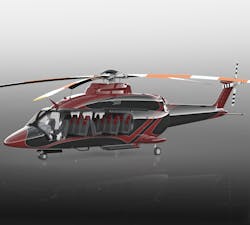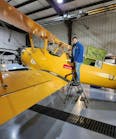Slated for entry into service in 2016, company officials tout the Bell 525 Relentless as being ready to revolutionize the helicopter industry as the world’s first fly-by-wire (FBW) commercial helicopter. The FBW system will use three flight control computers and triplex electro-hydraulic actuators in place of traditional mechanical control systems.
Matt Hasik, executive vice president, Commercial Business says, “The Bell 525 fly-by-wire flight control system represents the next generation of rotorcraft capability, a step-function change in both safety and aircraft performance. The 525 will be the first commercially certified fly-by-wire helicopter, providing tremendous situational awareness to the pilot – for instance, enabling the pilot to keep his/her eyes outside the cockpit while the aircraft maintains steady operational control.”
Fly by wire represents a significant change in the pilot’s ability to maintain control over the aircraft, during such critical missions as offshore oil and gas or search and rescue. The pilot can place the aircraft in a hover over a given spot without having to keep his/her hands on the cyclic or initiate a turn and the helicopter will maintain the attitude, heading, altitude, and speed commanded.
Use of composite materials
As a general rule, the Bell 525 utilizes composite parts on the outer mold line (OML) of the aircraft (sidebodies, doors, skins, fairings) as well as for major structural components. This includes fuel tank enclosures, keel beams, bulkheads, floor panels, as well as most of the aft fuselage, tailboom, and empennage. Michael Deslatte, manager, IPT Engineering, 525 Relentless Airframe, says, “These decisions were based on design trade studies in preliminary design that helped determine the cost/weight trade for each configuration.”
Deslatte goes on to describe the largest composite parts are the cockpit and main cabin sidebodies, the one-piece composite boat hull, the roof deck, and the LH and RH tailboom skins. Deslatte says, “Because one of the design goals of the Bell 525 was a reduction in part count and removal of joints, many of our composite parts are larger than one might expect. We used unitized composite structures to lower overall cost as there are fewer parts to source and manage. This process also reduces the number of joints which, historically, has been a source of corrosion and premature failure in rotorcraft.”
The remaining metallic components in the airframe are typically used where major external loads are introduced such as roof beams, nose landing gear support keels, main landing gear spars and carry-through, nose windshield center post, tail rotor gearbox support fitting, and similar areas.
Design Philosophy Improves Maintenance
One way Bell Helicopter drives improved maintenance is through its Maintenance Steering Group-3 (MSG-3). The MSG-3 process, used on the Bell 429, Bell 525, and Bell 505 aircraft, is a top-down methodology allowing Bell Helicopter product support engineers to determine the most appropriate scheduled maintenance task(s) and interval(s) for the aircraft’s major components and aircraft structure. MSG-3 based maintenance is designed to drive improvement in aircraft availability and to build in operational safety nets while optimizing cost of ownership.
Through significant data analysis, MSG-3 develops a reliability-centered-maintenance (RCM) program. The RCM program helps determine failure modes which may cause functional failures and develops subsequent maintenance tasks to prevent them. This approach differs from traditional maintenance processes, where all components are overhauled at a specified time, regardless of their current performance.
”MSG-3 isn’t new to aviation, but is relatively new to the rotorcraft industry. Bell Helicopter was the first rotorcraft OEM to use the Maintenance Steering Group-3 (MSG-3) process; it was used on the Bell 429 and it is currently being used on the Bell 525 and Bell 505,” says Margaret Triantafyllou, supervisor, Product Support Engineering. “This team-based approached allows us to develop the Initial Maintenance Schedule for the aircraft.” The MSG-3 analysis covers aircraft systems, structures, zonal inspections, enhanced zonal inspections, and L/HIRF.
The Bell 525 Relentless has some very robust design requirements for maintainability. All line replaceable units (LRUs) are replaceable within 30 minutes or less. The Bell 525 team accomplished this by developing a functional and simplified workspace with a limited list of common fasteners for designers to choose from, preventing annoyances like finding a Phillips-head screw next to a Torx-head screw. Similarly, fasteners within the same row are required to have the same grip length. Another example of simplified maintainability is the interchangeable panels and windscreens.
The aircraft was designed to minimize the need to remove major structural access panels and unrelated system components to gain access to troubleshoot, remove, inspect, clean, and reinstall LRUs. Placement of system components in the structure was considered to ensure they were readily accessible and easily removable. Additionally, human factors software was used to model various maintenance scenarios for the 20th percentile female and 95th percentile male mechanic to perform common maintenance procedures.
From a maintenance and reliability perspective, Bell Helicopter’s Integrated Vehicle Health and Monitoring (IVHM) system allows considerably more complex data to be pulled from the aircraft than what is available on today’s aircraft. The IVHM system is a connected network allowing Bell Helicopter to gather critical fleet information for analysis. This data is then shared with operators and maintainers for more efficient aircraft management and operations. In addition, Bell Helicopter will work with its customers to facilitate the transfer of aircraft and maintenance data from operators to suppliers to improve customer support, supply chain, and product designs.
The Bell 525’s design engineers were also put into the maintenance environment, allowing them to experience the results of all of their designs. The result was collaboration between design and maintenance that led to efficiencies in maintainability. The team also trained in Computer Aided 3-D Interactive Application (CATIA®) which gives them access to models in real time so they can promptly identify maintenance issues. This led to construction of numerous mockups for additional practice and diagnostics. Discoveries made during using these mockups led to suiting the components of the Bell 525 Relentless to a variety of body types so they are safely and easily accessed by a majority of maintainers.
Since inception of the Bell 525 program Bell Helicopter has worked closely with its Customer Advisory Panel (CAP) on the design of the aircraft to ensue produceability and maintainability. The CAP is made up of a cross-section of customers, including maintainers, who use a variety of Bell aircraft for various missions.
Maintenance is planned to be a mix of operator field maintenance, and Bell Helicopter Service Centers and/or select Bell Helicopter Authorized Service Facilities capable of performing larger maintenance tasks that the customer may not have the capability to perform.
New Aircraft New Training
According to Charles Fisher, senior manager, Domestic Training Operations for the Bell Helicopter Training Academy (BTA), the Bell 525 aircraft maintenance training program expands on Bell Helicopter’s history of supporting its aircraft to take advantage of the unique technology that makes the Bell 525 a very maintenance friendly aircraft. The technician’s basic A&P mechanical and avionics skills are supplemented with training on how to read and act upon the unique diagnostic information being fed from the aircraft to the IVHM system. Understanding the robust monitoring and reporting resources of the Bell 525 simplifies both basic aircraft maintenance and advanced troubleshooting.
The BTA is using 3-D-rendered, high fidelity, interactive graphics to represent aircraft components and step-by-step maintenance actions, including nomenclature and special required tools. Fisher says, “These graphics have digital picture quality for an authentic representation of each component. As BTA instructors provide detailed instruction on system description, theory of operation, and component orientation, they can depict coordinating component representations and system assemblies at student stations. These media elements are interactive, via instructor smart-board manipulation and student workstation touch screens.” The interactive, 3-D technology allows students to work at their own speed and to “play” with various components of the aircraft from their personal computer or tablet - enhancing student mastery of maintenance actions while reducing the time it takes to perform these actions once hands-on training begins.
The Bell 525 maintenance training will offer customers more geographical flexibility and customization. “We will increase the capability of our customers to access systems descriptions and theory of operation content remotely. Furthermore, we continue to develop our global training strategy to allow customers regional access to training,” says Fisher.
More can be found by visiting www.bellhelicopter.com.


